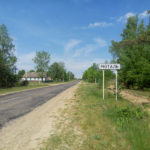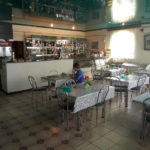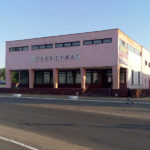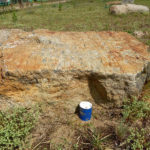
מאת: דוד לחמי
החלטנו לנסוע לבלארוס ולבקר במוטלה – העיירה ממנה הגיעה משפחת אייזנברג. הדרך מונוטונית (כביש הסרגל, רק שאורכו כ-300 ק"מ). הנוף קבוע וכמעט אינו משתנה – יערות עד או שדות ירוקים/צהובים. הארץ מישורית לגמרי. פה ושם עוברים נקודות ישוב קטנות. באזור הכפרי לא כל הדרכים סלולות ומדי פעם עוברים לדרכי עפר.
ידעתי שמוטלה היא "חור". מסתבר שלא ידעתי עד כמה…
בקצה הדרך – הפתעה !!! מדובר על כפר של כ-4,0000 תושבים. המון בתים, חדשים וגם ישנים, בני קומה אחת, חלקם אבן וחלקם עץ. מוטלה יחסית מפותחת לעומת הכפרים שסביבה. יש בה בניין עירייה, מוזיאונים, כמה בתי ספר אזוריים גדולים, בית קפה, סניף דואר וסניף בנק, מרכז מוזיקה ומחול, מכולת, כספומט וגם מלון שבו אנו ישנים – חדרים פשוטים אך נעימים, מקלחת בכל חדר, טלוויזיה קטנה, אך העיקר – יש Wi-Fi.
הרחובות הראשיים סלולים אך כשיורדים לרחובות הצדדיים יש רק דרכי עפר ומגלים שלא הרבה השתנה מלפני 100 שנה. מכל עבר יש בתי עץ עם גגות רעפים גבוהים. חלקם צבועים (צהוב, ירוק וכחול הם הצבעים הנפוצים) וחלקם לא. כל בית נמצא בחזית של חלקת אדמה מוקפת גדר, כשמאחורי הבית יש אדמה מעובדת לגידולים שונים (כגון תפו"א, עגבניות, מלפפונים וכו') ומבנה קטן נוסף לבעלי החיים.
העיירה שוכנת באזור ביצתי שבו מי התהום נמצאים קרוב מאוד לקרקע. בכל בית יש באר. מקורות מים פתוחים נמצאים בכל מקום ובעיקר אגם גדול בצפונה של העיירה.
בית הקברות הנוצרי פורח ומטופח. בית הקברות היהודי הישן (היה בשימוש עד סוף המאה ה-19), שנמצא בתוך הכפר, שוקם ע"י מרטין ברקין מלונדון (קרוב משפחה ממשפחת אייזנברג) – הקימו גדר המקיפה את שטח בית הקברות ושמו לוח זיכרון. בית הקברות השני, החדש יותר (היה בשימוש מתחילת המאה ה-20) היה מחוץ לכפר ואין לו סימן כיום. כל המצבות של שני בתי הקברות נעקרו ממקומם בתקופה הסובייטית ושימשו למפעלי הבנייה המקומיים (סכרים וכו'). לפני מספר שנים נמצאו במהלך עבודות מספר מצבות אשר הועברו לבית הקברות הישן ופוזרו בשטחו בצורה אקראית – צילמתי את כל המצבות והדלקתי נר זיכרון במקום.
ביקרנו בבית שבו התגורר בילדותו חיים וויצמן, נשיאה הראשון של ישראל. הזדמנות לראות איך נראים הבתים מבפנים. החצר משמשת כיום כשטח מראה לכמה גדיים.
במוזיאון המקומי יש תערוכה של התרבות המקומית – שום סימן לחיים היהודיים שהיו במקום.
אתר ההנצחה ממוקם במקום בו נרצחו כל תושביה היהודים של מוטלה – בור בשדה חרוש מחוץ לכפר. כיום המקום מוקף גדר ובו מצבת זיכרון. בצמוד למצבה הונחו זרי פרחים צבעוניים קבועים מפלסטיק (בדומה למצב בכל אתרי ההנצחה האחרים שביקרנו בהם במהלך הטיול).
So we decided to go to Belarus and visit Motele – the town from which my Eisenberg family arrived. The road is monotonous (350 km from Minsk), the landscape is fixed and almost never changes – forests or green/yellow fields, the country is completely flat, small towns and villages are scattered here and there. I knew that Motele was a "hole." I did not know how much …
At the end of the road – surprise!!! This is a village of about 4,000 inhabitants. Lots of one story houses, new and old, some made of stone and some made of wood. Motele is relatively developed compared to the surrounding villages. There is a municipal building, museums, a few large regional schools, a coffee shop, a post office and a bank branch, music and dance center, a grocery store, an ATM and a hotel where we sleep – simple but pleasant rooms, shower in every room, small TV, but the main thing – there is Wi-Fi.
The main streets are paved but when you go down to the side streets there are only dirt roads and you discover that not much has changed from 100 years ago. On every side are wooden houses with high tiled roofs. Some are painted (yellow, green and blue are the common colors) and some are not. Each house is located on the front of a plot of land surrounded by a fence. Behind the house there is cultivated land for various crops (such as potatoes, tomatoes, cucumbers, etc.) and a small structure for animals.
The town is located in a swampy area where groundwater is very close to the ground. Every house has a well. Open water sources are everywhere, especially a large lake in the north of the town.
The Christian cemetery is flourishing and well maintained. The old Jewish cemetery (used until the end of the 19th century), located inside the village, was restored by Martin Berkin of London (a relative of the Eisenberg family). They erected a fence surrounding the area of the cemetery and placed a memorial plaque. The second, newer cemetery (used since the beginning of the 20th century) was outside the village and has no sign today. All the tombstones of the two cemeteries were taken in the Soviet period and used for local construction projects (dams & etc.). A few years ago, a number of tombstones were found and transferred to the old cemetery and dispersed in its territory in a random manner – I photographed all the tombstones and lit a memorial candle in the site.
We visited the house where Chaim Weizmann, the first president of Israel, lived as a child. An opportunity to see how the houses look like from within. The yard now serves as a mirror area for several young goats.
The local museum has an exhibition of local culture – no sign of Jewish life.
The memorial site is located where all the Jewish residents of Motele were murdered – a hole in a plowed field outside the village. Today the site is surrounded by a fence with a memorial monument. Next to the tombstone lay colored plastic wreaths (similar to all the other memorial sites we visited during the trip).











































